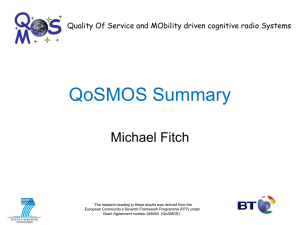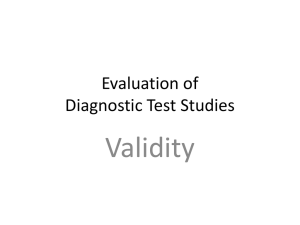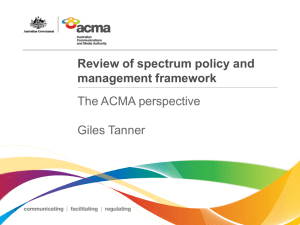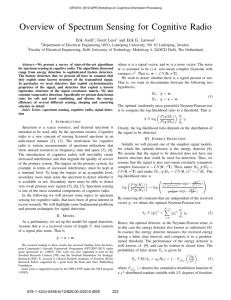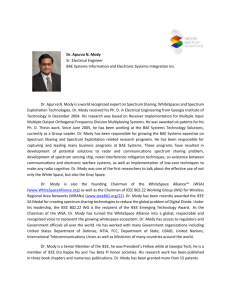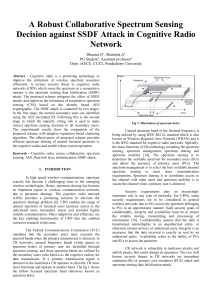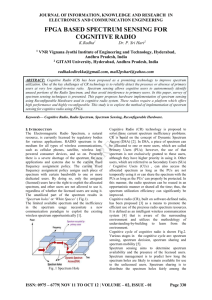slides
advertisement
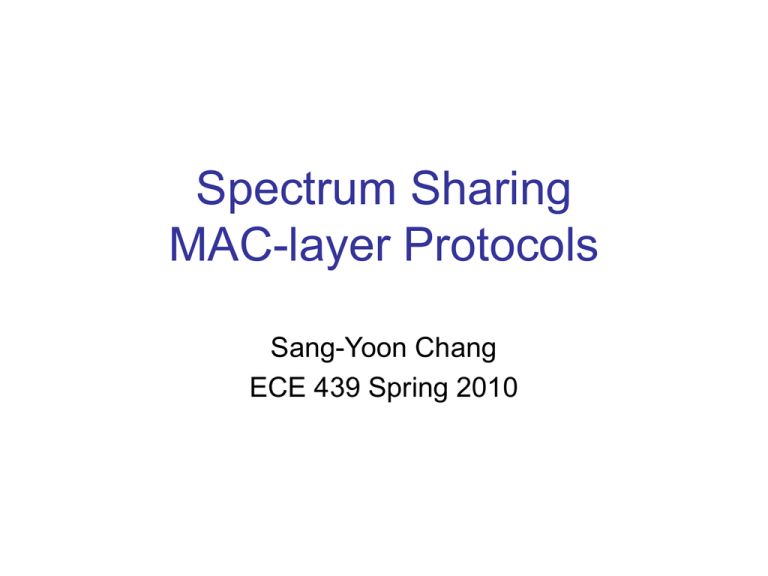
Spectrum Sharing MAC-layer Protocols Sang-Yoon Chang ECE 439 Spring 2010 Motivation • Bandwidth becoming scarcer and more valuable – Increased demands on wireless applications – Users demand higher performance • Dynamically accessing multiple channels can increase spectrum efficiency • Our goal is to support multiple transmissions and increase performance by mitigating interference FCC Spectrum Allocation Chart Spectrum Utilization A snapshot of spectrum utilization up to 6 GHz in an urban area at mid-day [1] Background • Cognitive radio – Secondary users operating on licensed Band – Required to detect primary users’ signals (physical-layer) – Avoid and yield the channel use to primary users (MAC-layer) • In addition, coordination with other secondary users • Other Spectrum Sharing Techniques – Ultra WideBand (UWB) Communication – Unlicensed Band, e.g., ISM band Project Overview • • • • • • Random access protocol without coordination [2] Centralized channel allocation algorithm [3] Distributed channel allocation algorithm [4],[5] Single radio per user [6],[7] MMAC [6], HMAC [7] Sensing overhead / limitations [7],[8] Diverging from traditional slotted channelization SWIFT [10] [7],[10],[11],[12] • Selfish users [14] Hidden-Terminal Problem • In single-channel environment, IEEE 802.11 DCF, busy-tone • Assumed single radio per user • IEEE 802.11 DCF in multichannel environment • C does not hear the CTS(2) from B, and thus collision • If multiple radios per user, Dynamic Channel Assignment (DCA) by Wu [9] – Needs complex hardware MMAC Protocol • Multi-Channel MAC (MMAC) by So and Vaidya [6] • Single radio per user • Build on IEEE 802.11 PSM protocol (beacon interval, ATIM) • Requires global synchronization • In ATIM window, – Agree on a channel according to Preferable Channel List (High, Medium, Low) – ATIM-RES to notify the channel reservation Beacon Interval MMAC Performance • Compared to DCA [9] and IEEE 802.11 • WLAN (above) and multihop (below) environment • Also observed packet delay • CBR traffic • Packet size = 512 Bytes • Beacon interval = 100 ms • ATIM window size = 20 ms • 3 channels HC-MAC Protocol • Hardware-Constrained Cognitive MAC (HC-MAC) by Jia et al. [7] • Single radio, partial spectrum sensing, spectrum aggregation limit • Construct a stopping problem to decide whether or not to sense further channels • Robust to multi-channel hidden terminal problem HC-MAC: Sensing Decisions BT T 3t 2 BT Rb T 3t Rc Rc * BT T 3t B = Transmission Rate, T = Packet Duration, t = Sensing Time * HC-MAC: Control Packets • Contention (C-RTS / C-CTS) – Competing for common control channel access • Sensing (S-RTS / S-CTS) – Exchange channel availability and agree on data channel • Transmission (T-RTS / T-CTS) – Notify neighboring nodes the completion of transmission SWIFT Protocol • Split Wideband Interferer Friendly Technology (SWIFT), Rahul [10] • Unlike UWB, no need to sacrifice transmission power, rate • Cognitive aggregation of non-contiguous frequency band • Adaptive sensing (probe the spectrum and observe reaction) SWIFT: Adaptive Sensing (sec) SWIFT Bin Sync. Problem SWIFT: Bin Synchronization • SWIFT users independently decide which bands that they can use. i) If drastic disagreement on usable bands, or boot up – Sends usable bins in all frequency bins – Txer and Rxer agrees at least on one of the bins ii) If limited disagreement, – Stripes data across the previously agreed bins, but transmits only in the subset that is still usable – Transform the potential disagreement to bit errors – Error correcting codes Discussion and Conclusion • Security issues arise, e.g., Denial-of-Services (primary user emulation, jamming, etc.) – Analyzed correctness and performance of schemes assuming rational users (who care for their performances) • With smart radio becoming reality, burgeoning interest in MAC protocols that are designed for multi-channel environment References [1] R. W. Brodersen, A. Wolisz, D. Cabric, and S. M. Mishra, “CORVUS: A Cognitive Radio Approach for Usage of Virtual Unlicensed Spectrum,” 2004. [2] S. Huang, X. Liu, and Z. Ding, “Opportunistic Spectrum Access in Cognitive Radio Networks,” IEEE Infocom, 2008. [3] T. Shu and M. Krunz, “Coordinated Channel Access in Cognitive Radio Networks: A Multi-Level Spectrum Opportunity Perspective,” IEEE Infocom, 2009. [4] J. Zhao, H. Zheng, and G.-H. Yang, “Distributed Coordination in Dynamic Spectrum Allocation Networks,” IEEE DySPAN, 2005. [5] L. Cao, H. Zheng, and G.-H. Yang, “Distributed Coordination in Dynamic Spectrum Allocation Networks,” IEEE CrownCom, 2007. [6] J. So and N. Vaidya, “Multi-Channel MAC for Ad Hoc Networks: Handling Multi-Channel Hidden Terminals Using a Single Transceiver,” ACM MobiHoc, 2004. [7] J. Jia, Q. Zhang, and X. Shen, “HC-MAC: A Hardware-Constrained Cognitive MAC for Efficient Spectrum Management,” IEEE Journal on Selected Areas in Communications, vol. 26, no. 1, pp. 106-117, 2008. [8] S. Shetty, M. Song, C. Xin, and E. K. Park, “A Learning-Based Multiuser Opportunistic Spectrum Access Approach in Unslotted Primary Networks,” IEEE Infocom, 2009. [9] S.-L. Wu, C.-Y. Lin, Y.-C. Tseng, and J.-P. Sheu, “A New Multi-Channel MAC Protocol with On-Demand Channel Assignment for Multi-Hop Networks,” ISPAN, 2000. [10] H. Rahul, N. Kushman, D. Katabi, C. Sodini, and F. Edalat, “Learning to Share: Narrowband-Friendly Wideband Networks”, ACM Sigcomm, 2008 [11] Y. Yuan, P. Bahl, and R. Chandra, “KNOWS: Kogitiv Networking Over White Spaces,” IEEE DySPAND, 2007. [12] P. Bahl, R. Chandra, T. Moscibroda, R. Murty, and M. Welsh, “White Space Networking with Wi-Fi Like Connectivity,” Sigcomm, 2009. [14] R. Etkin, A. Parekh, and D. Tse, “Spectrum Sharing for Unlicensed Bands,” IEEE Journal on Selected Areas in Communications, vol. 25, no. 3, p. 517, 2007.

